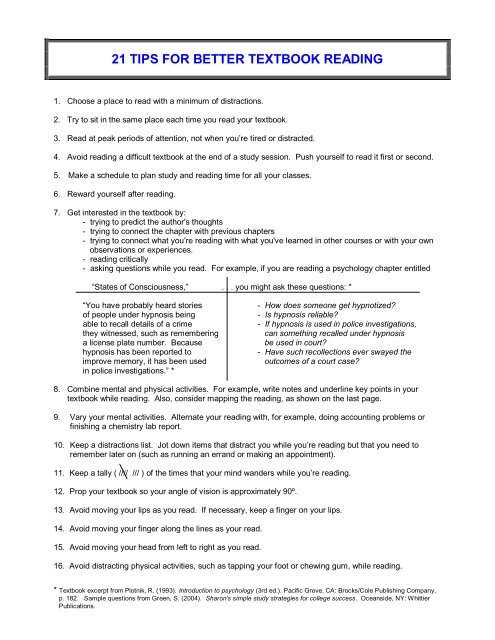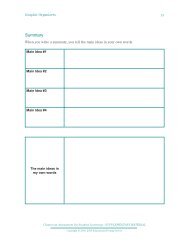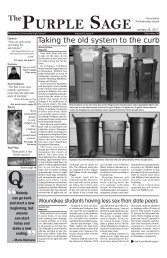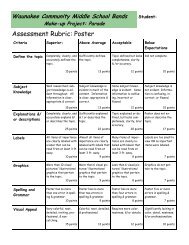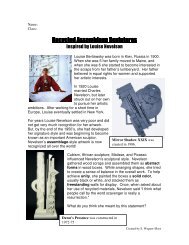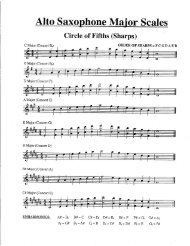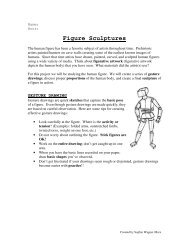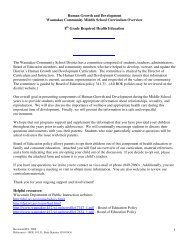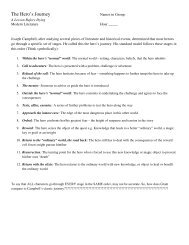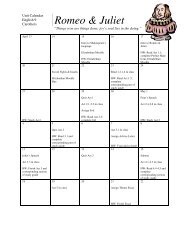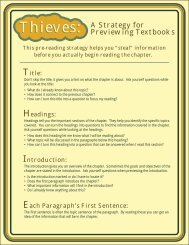21 Tips for Better Textbook Reading
21 Tips for Better Textbook Reading
21 Tips for Better Textbook Reading
You also want an ePaper? Increase the reach of your titles
YUMPU automatically turns print PDFs into web optimized ePapers that Google loves.
<strong>21</strong> TIPS FOR BETTER TEXTBOOK READING1. Choose a place to read with a minimum of distractions.2. Try to sit in the same place each time you read your textbook.3. Read at peak periods of attention, not when you’re tired or distracted.4. Avoid reading a difficult textbook at the end of a study session. Push yourself to read it first or second.5. Make a schedule to plan study and reading time <strong>for</strong> all your classes.6. Reward yourself after reading.7. Get interested in the textbook by:- trying to predict the author's thoughts- trying to connect the chapter with previous chapters- trying to connect what you’re reading with what you've learned in other courses or with your ownobservations or experiences.- reading critically- asking questions while you read. For example, if you are reading a psychology chapter entitled“States of Consciousness,” . . . you might ask these questions: *“You have probably heard storiesof people under hypnosis beingable to recall details of a crimethey witnessed, such as rememberinga license plate number. Becausehypnosis has been reported toimprove memory, it has been usedin police investigations.” *- How does someone get hypnotized?- Is hypnosis reliable?- If hypnosis is used in police investigations,can something recalled under hypnosisbe used in court?- Have such recollections ever swayed theoutcomes of a court case?8. Combine mental and physical activities. For example, write notes and underline key points in yourtextbook while reading. Also, consider mapping the reading, as shown on the last page.9. Vary your mental activities. Alternate your reading with, <strong>for</strong> example, doing accounting problems orfinishing a chemistry lab report.10. Keep a distractions list. Jot down items that distract you while you’re reading but that you need toremember later on (such as running an errand or making an appointment).11. Keep a tally ( //// /// ) of the times that your mind wanders while you’re reading.12. Prop your textbook so your angle of vision is approximately 90º.13. Avoid moving your lips as you read. If necessary, keep a finger on your lips.14. Avoid moving your finger along the lines as your read.15. Avoid moving your head from left to right as you read.16. Avoid distracting physical activities, such as tapping your foot or chewing gum, while reading.* <strong>Textbook</strong> excerpt from Plotnik, R. (1993). Introduction to psychology (3rd ed.). Pacific Grove, CA: Brocks/Cole Publishing Company,p. 182. Sample questions from Green, S. (2004). Sharon's simple study strategies <strong>for</strong> college success. Oceanside, NY: WhittierPublications.
17. As you read, think of the writer, the real person behind the print. Consider why and how that personwrote what you are reading. Also, consider how that author chose to organize the material and why.18. Treat reading as only the first step in the reading process. One reading is seldom enough. Formastery, you’ll also need to re-read, review, write summaries, and/or discuss the material with others.19. Think of reading as communication and thinking.20. Establish a purpose <strong>for</strong> reading each chapter and each section, by turning the headings into questions.Try to begin your questions with "WHAT," "HOW," and "WHY," because they lead to more detailedresponses. Search <strong>for</strong> the answers while you read; this can lead to more active reading.For the biology heading “Regulation of Bile Release,” ask “How is bile release regulated?” Then read tofind the answer. For the history heading “Dawn of the Atomic Age,” begin with the question “When didthe Atomic Age begin?” and continue with questions such as “How did the Atomic Age develop?” or“How did the Atomic Age alter life in the 20th century?” The active thinking needed to write suchquestions will lead to greater understanding of the material.Also, connect subheadings to broader headings. This heading in a sociology textbook “Problems of theElderly” is followed by the subheading “Housing and Health Care.” Connect these two headings byasking “Why is housing a problem <strong>for</strong> the elderly?” or “How can health care be improved <strong>for</strong> theelderly?” Don’t these sound like test questions? *<strong>21</strong>. Use the "S-Q-3R" method, but add a "W" step. “S-Q-3R" stands <strong>for</strong> "Survey - Question – Read - Recite- Review." This is a systematic approach to reading which includes taking specific actions be<strong>for</strong>e youbegin to read, and then additional actions after you finish reading. Here's a brief description:Survey - In 2-5 minutes, glance over the headings in the chapter to discover the main pointsthat will be developed. Also, read the summary paragraph, if there is one.Question - Turn each heading into a question. This arouses your curiosity, thereby increasing yourcomprehension. The questions can also help you distinguish the main point from theexplanatory details. Turning headings into questions is easy, but it requires a consciousef<strong>for</strong>t on your part.Read - Read carefully, to answer the question (usually to the end of that headed section).Actively search <strong>for</strong> the answer.Recite -Now look away from the book and see if you can recite the answer to each of yourquestions. Use your own words and include an example. If you can do this, you knowwhat you’ve read. If you can't, glance back over the section. An excellent way to dothis reciting from memory is to jot down cue phrases in outline <strong>for</strong>m on a sheet of paper.Make these notes very brief.Review - After you’ve read the material, review your notes to get a bird’s-eye view of the pointsand their relationship, and check your memory of the content by reciting the majorsubpoints under each heading. Cover up the notes and try to recall the main points.Then uncover each major point and try to recall the subpoints listed under it.Write - This is an extension of “Review.” In addition to thinking about what you remember, writethe material down. Write lists, write summaries, write answers to questions. Writinghelps you commit the material to memory.* from Green, S. (2004). Sharon's simple study strategies <strong>for</strong> college success. Oceanside, NY: Whittier Publications.Office of Academic SupportNiagara Universityhttp://www.niagara.edu/oas-study-reading-strategies/


